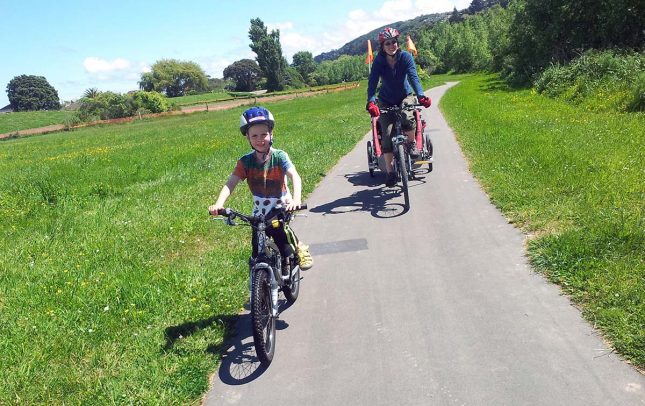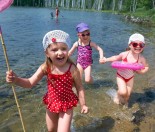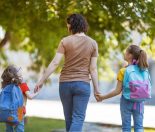Good weather and school holidays are just the excuse you’ve been looking for to get out on your bikes. What better way to wear out your kids, get outdoors and have fun together. Read our top tips for cycling with kids and keeping it safe and fun these holidays.
Have you been hibernating over winter? Are you looking for a way to get active and healthy while having some fun with your kids these holidays? Then brush off the cobwebs from your bikes, pump up your tyres and get ready to have some family fun. Not only does cycling together as a family get you outdoors and into the fresh air, but it’s totally free, and you’ll be getting fit while having fun! What’s better than that?
Better than fun
Kids and bikes go together. At the opening of her school bike track, 8 year old Katelyn exclaimed, “this is better than fun”. She was referring to the speed and freedom of riding a bike, the sense of satisfaction at mastering a new skill, the fun of riding with her friends, and doing her bit for the planet. You just know when kids are calling it ‘better than fun’, that you’ve found an activity they really love.
Cycling Goodness
What kids experience is fun; but it comes in an unbeatable package deal which includes: exercise, fresh air, family time, skill development, learning and experiencing the outdoors and being part of their neighbourhood and community. Riding a bike creates more vibrant and connected communities and is a whole lot of goodness: good for you, good for the planet and good fun!
Top 10 tips for cycling with kids
While the kids focus on fun, the grown ups of course want to make it safe and enjoyable, so here are some top tips for safer cycling fun these holidays.
- Safe bikes and safe heads. Before you head out, pump up your tyres, check your brakes are working and that your helmet fits well (and is on your head, not your handlebars, which need far less protection than your brain!). Check out these helpful safety tips from the New Zealand Transport Agency.
- Choose your own adventure. If you want the thrills of speed and to dial up your skills, then see if a school near you has a bike track. These tracks are designed to be a fun and safe place for kids to ride fast and show off / develop their skills. Ask around or check out this handy map to find one nearby. Other places to cycle include: your neighbourhood, local parks (especially those with bike tracks), and cycle paths including the NZ Cycle Trail. Your local council or i-site may have cycling maps and information. If off-road is your scene check out BMX clubs and MTB parks in your area. Check out New Zealand’s best places to cycle.
- Suss out those ‘sneaky driveways’. Driveways can be a concern, especially if you’re using the footpath. Often drivers have poor visibility, and some just don’t check. Teach your kids about ‘sneaky driveways’ to help them identify the ones they have to be especially careful of. Teach them about listening and looking for any sign of a vehicle on the move.
- Stay in control. Riding a bike is a great way for kids to learn about speed and control. Encourage them to choose a safe speed, appropriate for where they’re riding. That means a speed at which they can control their bike and safely stop if required. If your kids are legally using the footpath that means slower riding, and even slower when there are other people about or visibility is limited (e.g. blind corners). Ride together and emphasise the need to stay within ‘earshot’ where they can hear you. That way you can coach them about adjusting their speed for the terrain, different surfaces, corners, and intersections.
- Stop and hop. Crossing the road is an occasion where child cyclists are particularly at risk. Teach your kids to stop at the kerb, hop off their bike, check for safety, and then walk their bike across the road. This helps their brains distinguish between the process of riding and the process of crossing safely. They can master each activity separately before trying to combine them.
- Make space. Kids have a different sense of personal space to adults! Encourage your kids to allow plenty of space when passing other people. That might mean going onto the grass verge or dismounting and walking their bike, and definitely slowing down. This is especially true when passing from behind: ‘make space especially when you can’t see their face’. Encourage your kids to be aware that older folk don’t see, hear or move as well as they do! Care, consideration and manners go a long way.
- Get noisy on the path. Yep, encourage your kids to be noisy riding on a footpath or shared path. Nobody likes that surprise ‘whoosh’ factor when someone appears from out of nowhere and passes them. So as well as giving other path-users lots of space, make some noise. That could mean ringing a bell, calling out a friendly greeting, singing a song, or whatever friendly cheerful noise your child excels at (although you may have trouble getting the drum kit onto the bike). Spokey-dokes anyone?
- Make a ‘sandwich’. When your kids are ready to ride on the road with you, if possible, make a ‘sandwich’: an adult leading who sets the course and points out obstacles and hazards; children in the middle; and another adult at the rear, slightly to the outside. The rear adult is the ‘sweep’: they coach the children’s riding and remind them about the safety skills they need to use. Before you take your kids riding on the road you need to be confident in your own riding abilities as well as theirs. If not, you can always use the sandwich technique on an off-road cycle path. It’s fun to decide what filling the kids want to be: ham and cheese, or lettuce and tomato?
- Be safe, be seen. Bright clothing or visibility vests help riders stand out from their background. Next time your kids need a new rain jacket, seek out brightly coloured ones, preferably with reflective strips. That way they can walk, scoot or cycle to school whatever the weather, and they will be much more visible to drivers. If you have trouble finding one then check out the kids jackets from www.roadworks.co.nz.
- Learn from your kids. If your kids have done cycle skills training at school they may be full of useful information and pointers, which they can’t wait to pass on. Use this as an opportunity to brush up on your own knowledge of road rules and safety know-how. For more information about equipment and behaviour rules go to the New Zealand Transport Agency website.
Under New Zealand Law it is illegal to cycle on the footpath unless your wheels are smaller than 35.5mm diameter or you are delivering post or newspapers.
For more expert advice on wellbeing activities with your kids, check out our School age: Health & Wellbeing section







